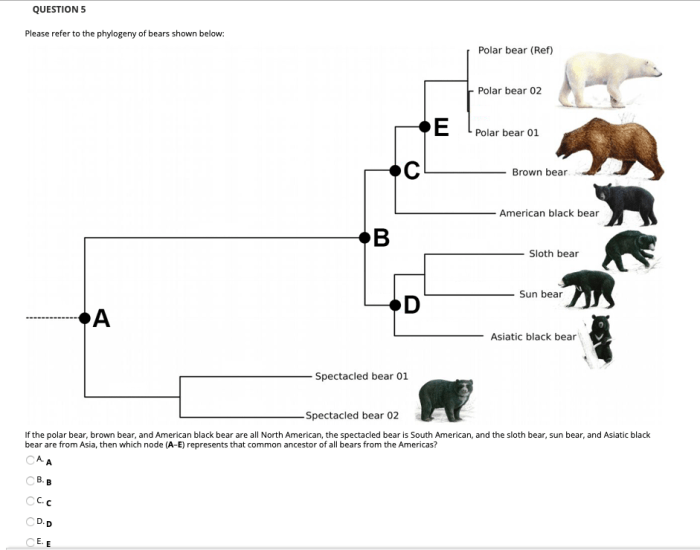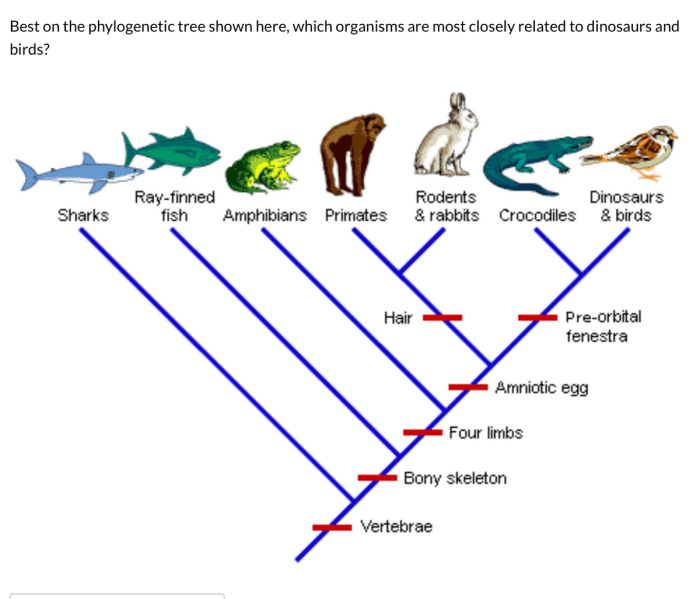The Phylogenetic Tree Worksheet with Answers is an invaluable resource for students and researchers seeking to unravel the intricate tapestry of evolutionary relationships. This worksheet provides a structured framework for visualizing and comprehending the branching patterns of diverse taxa, fostering a deeper understanding of the processes that have shaped the diversity of life on Earth.
Through its visually appealing and informative design, the worksheet seamlessly integrates data visualization techniques, interactive elements, and comprehensive content to engage learners and enhance their grasp of evolutionary biology concepts.
Phylogenetic Tree Worksheet with Answers

Phylogenetic trees are graphical representations of evolutionary relationships among different species or taxa. They are used to depict the branching patterns and evolutionary distances between organisms, providing valuable insights into the history of life on Earth.
A worksheet is an educational tool designed to guide students or researchers through a specific learning activity. In the context of phylogenetic trees, a worksheet can help individuals visualize and understand evolutionary relationships by providing structured guidance and prompts.
The target audience for a phylogenetic tree worksheet can vary depending on the educational level and context. It can be designed for students in introductory biology courses, advanced undergraduate or graduate students, or researchers working in the field of evolutionary biology.
Phylogenetic Tree Worksheet Design, Phylogenetic tree worksheet with answers
An effective phylogenetic tree worksheet should be visually appealing and informative, providing a clear and organized representation of evolutionary relationships. The following guidelines can be considered when designing a worksheet:
- Use clear and concise language, avoiding technical jargon or overly complex terminology.
- Incorporate visual elements such as diagrams, charts, and tables to illustrate evolutionary relationships.
- Consider using interactive elements, such as drag-and-drop exercises or online simulations, to enhance engagement and understanding.
- Provide ample space for students to make notes, answer questions, and draw connections between different parts of the tree.
Worksheet Content
The content of a phylogenetic tree worksheet should include the following information:
- Taxa names and characteristics:The worksheet should clearly identify the taxa (species or groups of organisms) included in the tree and provide brief descriptions of their key characteristics.
- Branch lengths and evolutionary distances:The worksheet should indicate the branch lengths on the tree, which represent the evolutionary distances between taxa. These distances can be based on genetic data, morphological similarities, or a combination of both.
- Root and outgroup selection:The worksheet should explain the rationale for selecting a root (the common ancestor from which all taxa in the tree are descended) and an outgroup (a species or group of species that is used as a reference point for comparison).
Answer Key Development
An answer key is an essential component of a phylogenetic tree worksheet, providing students or researchers with accurate and detailed explanations of the tree and its implications. The following guidelines can be considered when developing an answer key:
- Provide clear and concise written explanations for each question or prompt on the worksheet.
- Include visual representations, such as annotated diagrams or tables, to illustrate the answers.
- Ensure that the answer key aligns with the learning objectives of the worksheet, addressing the specific concepts and skills that students are expected to develop.
Educational Applications
Phylogenetic tree worksheets can be used in a variety of educational settings to teach evolutionary biology concepts. Some examples include:
- Introductory biology courses:Worksheets can help students visualize the concept of evolutionary relationships and understand the principles of phylogenetic tree construction.
- Advanced undergraduate or graduate courses:Worksheets can be used to explore more complex topics, such as molecular evolution, population genetics, and comparative genomics.
- Research projects:Worksheets can guide students in designing and interpreting phylogenetic trees as part of their research projects.
FAQ Explained: Phylogenetic Tree Worksheet With Answers
What is the purpose of a phylogenetic tree worksheet?
A phylogenetic tree worksheet is designed to provide a visual representation of evolutionary relationships among different taxa, aiding in the understanding of their shared ancestry and genetic relatedness.
How can I use a phylogenetic tree worksheet in my classroom?
Phylogenetic tree worksheets can be incorporated into lessons on evolutionary biology, genetics, and biodiversity. They can be used to introduce concepts such as common ancestors, homologous structures, and the processes of speciation and extinction.
What are the benefits of using a phylogenetic tree worksheet with answers?
Using a phylogenetic tree worksheet with answers provides learners with a structured and guided approach to understanding evolutionary relationships. The answers serve as a valuable resource for self-assessment and reinforcement of key concepts.

